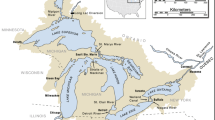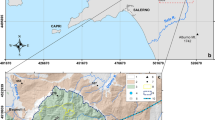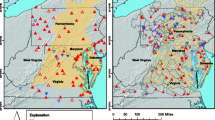Abstract
For Narragansett Bay, Rhode Island, newly calculated and archival data for the area, mean depth, total volume, mean salinity and fresh water input are presented. Estimates of the residence time of the water, derived from 22 sets of monthly mean values, were related to estimates of the fresh water input according to the empirical relationship T=41.8 e−0.00435(FW), where T is the flushing time in days, and FW is the fresh water input in m3 per s; the r2 value is 0.841. Adding estimates of the mean wind speed into a multiple regression increased the correlation coefficient only to 0.864. At the long-term mean rate of fresh water input (105 m3 per s) the flushing time is 26 days. At the lowest mean monthly input rate observed the flushing time was nearly 40 days, while at the highest mean monthly input rate in the data set (325 m3 per s) the flushing time was about 10 days. Known sources of random error appear sufficient to account for most of the deviations from the relationship. The evidence suggests that variation in the flushing time is largely determined by variation in the fresh water input.
Similar content being viewed by others
Literature Cited
Alexander, L. M. 1966. Narragansett Bay: a marine use profile. Final Report, contract Nonr-396(09) (NR-389-134), Geography Branch, Office of Naval Research.
Bolin, B., and H. Rodhe. 1973. A note on the concepts of age distribution and transit time in natural reservoirs. Tellus 25:58–62.
Dunn, C. Q., L. Z. Hale, and A. Bucci. 1979. The Bay Bib: Rhode Island Marine Bibliography, Revised Edition, Vols. I and II. Univ. of Rhode Island Mar. Tech. Repts. Nos. 70 and 71.
Dyer, K. R. 1973. Estuaries: A Physical Introduction, John Wiley and Sons, New York, 133 p.
Environmental Protection Agency. 1971. Report on Pollution of the Interstate Waters of Mt. Hope Bay and its Tributary Basins. Environmental Protection Agency, Washington, D.C. 70 p.+Append.
Gaines, A. G., Jr. 1975. Papers on the geomorphology, hydrography, and geochemistry of the Pettaquamscutt River Estuary. Dissertation for Ph.D., Univ. of Rhode Island. 278 p.
Haight, F. J. 1938. Currents in Narragansett Bay, Buzzards Bay, and Nantucket and Vineyard Sounds. U.S. Dept. Commerce, Coast and Geodetic Survey, Sp. Pub. No. 208. 101 p.
Hess, K. W. 1976. A three-dimensional numerical model of the estuary circulation and salinity in Narragansett Bay. Estuarine Coastal Mar. Sci. 4:325–338.
Hess, K. W., and F. M. White. 1974. A numerical tical model Narragansett Bay. Univ. of Rhode Island, Marine Technical Report No. 20. 141 p.
Hicks, S. D. 1959. The physical oceanography of Narragansett Bay. Limnol. Oceanogr. 4:316–327.
Hicks, S. D. 1963. Physical oceanographic studies of Narragansett Bay, 1957 and 1958. U.S. Fish & Wildlife Service, Spec. Sci. Rept.-Fisheries No. 457, Washington, D.C. 30 p.
Hicks, S. D., D. E. Frazier, and L. E. Garrison. 1956. Physical oceanographic effects of proposed hurricane protection structures on Narrgansett Bay under normal conditions. Submitted under contract DA-19-016-CIVENG-56-1071 to U.S. Army Corps of Engineers. Narragansett Marine Lab, University of Rhode Island, Ref. No. 56-12, Hurricane Protection Project, 66 p.
Hicks, S. D., T. J. Wehe, and R. Campbell. 1953. Inshore Survey Project. Final Harbor Report, Narragansett Bay and its Approaches; physical ocean-ography. Final Report under contract Nonr-396 (01) (NR-084-007). Narragansett Marine Laboratory, Univ. of Rhode Island, Ref. No. 53-12.
Ketchum, B. H. 1950. Hydrographic factors involved in the dispersion of pollutants introduced into tidal waters. J. Bos. Soc. Civil Eng. 37:296–314.
Ketchum, B. H. 1951. The exchanges of fresh and salt waters in tidal estuaries. J. Mar. Res. 10:18–38.
Ketchum, B. H. 1952. Circulation in estuaries. Proc. Third Conf. Coastal Eng., p. 65–76.
Kremer, J. N., and S. W. Nixon. 1978. A Coastal Marine Ecosystem: Simulation and Analysis. Springer-Verlag, NY, 217 p.
McCormick, J. M., R. I. Hires, G. W. Luther, and S. L. Cheng. 1983. Partial recovery of Newark Bay, NJ, following pollution abatement. Mar. Poll. Bull. 14:188–197.
National Oceanic and Atmospheric Administration. 1982. Local climatological data; monthly summary for Providence, Rhode Island: Annual summary for Providence, Rhode Island. National Oceanographic and Atmospheric Administration, National Climatic Data Center, Asheville, N.C.
Pritchard, D. W. 1955. Estuarine circulation patterns. Proc. Am. Soc. Civil. Eng. 81: No. 717, 11p.
Ricker, W. E. 1973. Linear regressions in fishery research. J. Fish. Res. Board Can. 30:409–434.
Ridley, E. L., and C. Ostricher, Jr. 1960. Flushing study of Narragansett Bay, Rhode Island. Informal oceanographic manuscript No. 18-60. U.S. Navy Hydrographic Office, Washington, D.C. Unpublished manuscript.
Schwartz, S. E. 1979. Residence times in reservoirs under non-steady-state conditions: application to atmospheric SO2 and aerosol sulfate. Tellus 31:530–547.
United States Army Corps of Engineers. 1981. Water Resources Development in Rhode Island 1981. U.S. Army Corps of Engineers, Waltham, MA.
United States Geological Survey. 1964. Compilation of records of Surface Waters of the United States, October 1950 to September 1960. Part 1-A, North Atlantic Slope Basins, Maine to Connecticut. U.S. Geol. Survey Water-Supply Paper 1721.
United States Geological Survey. 1972, 1973. Water resournces Data for Massachusetts, New Hampshire Rhode Island, Vermont. U.S. Geological Survey, Boston, MA.
United States Geological Survey. 1977, 1981. Water Resources Data, Massachusetts and Rhode Island. U.S. Geological Survey, Water Reports, MA-RI 77-1, 81-1.
Wehe, H. H. 1953. Inshore Survey Project, Final Harbor Report Narragansett Bay and its approaches. Physical Oceanography. Appendix A, Data Report submitted under contract Nonr-396 (01) (NR-084-007) to Office of Naval Research. Narragansett Marine Laboratory, Univ. of Rhode Island. Ref. No. 53-10.
Wehe, T. J. 1952. Inshore Survey Project; Preliminary Report of Existing Data, Narragansett Bay and Approaches. Part I. Physical Data submitted under contract Nonr 396 (01) (NR-084-007) to Office of Naval Research. Narragansett Marine Lab., Univ. of Rhode Island, Reference No. 52-5, 38 p.
Weisberg, R. H. 1976a. The non-tidal flow in the Providence River of Narragansett Bay: A stochastic approach to estuarine circulation. J. Phys. Oceanogr. 6:721–734.
Weisberg, R. H. 1976b. A note on estuarine mean flow estimation. J. Mar. Res. 34:387–394.
Weisberg, R. H., and W. Sturges. 1976. Velocity observations in the West Passage of Narragansett Bay: a partially mixed estuary. J. Phys. Oceanogr. 6: 345–354.
Author information
Authors and Affiliations
Rights and permissions
About this article
Cite this article
Pilson, M.E.Q. On the residence time of water in Narragansett Bay. Estuaries 8, 2–14 (1985). https://doi.org/10.2307/1352116
Received:
Accepted:
Issue Date:
DOI: https://doi.org/10.2307/1352116




